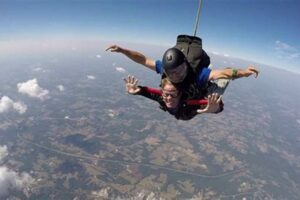Table of Contents
Unveiling the Ideal Skydiving Experience: Discovering the Best Time of Day to Take the Leap
When it comes to skydiving, timing is everything. The “best time of day to skydive” refers to the optimal conditions that contribute to a safe, enjoyable, and visually stunning skydiving experience. Picture this: as you soar through the sky, the sun’s golden rays illuminate the vast landscape below, creating a breathtaking panorama. This carefully chosen moment not only enhances the thrill but also ensures maximum safety.
The selection of the best time for skydiving extends beyond aesthetics. It’s influenced by several factors such as weather stability, wind speed, and visibility. Historically, skydiving was largely restricted to daytime jumps due to safety concerns. However, advancements in technology, training, and equipment have opened up the possibility of night skydiving, offering a unique perspective of the world below.
In this comprehensive guide, we’ll delve into the intricacies of choosing the best time of day for skydiving. We’ll explore the science behind weather conditions, unravel the impact of varying times on safety and enjoyment, and uncover the secrets to selecting the perfect moment for your skydiving adventure.
Best Time of Day to Skydive
The best time of day to skydive revolves around key aspects that impact safety, enjoyment, and the overall skydiving experience.
- Weather Conditions: Stability, wind speed, visibility.
- Time of Day: Morning, afternoon, evening, night.
- Sun Position: Angle, glare, sunset/sunrise.
- Temperature: Comfort, hypothermia, heatstroke.
- Cloud Cover: Scenic views, cloud formations, cloud base.
- Air Traffic: Congestion, safety regulations, airspace restrictions.
- Jumper Experience: Beginner, intermediate, experienced.
- Personal Preference: Thrill-seeker, nature lover, photography enthusiast.
These aspects are interconnected and influence each other. For instance, weather conditions dictate the time of day suitable for skydiving. Morning jumps offer calmer winds and stable atmospheric conditions, while sunset jumps provide stunning visuals. The jumper’s experience level also plays a role; beginners may prefer daytime jumps for better visibility, while experienced jumpers might relish the challenges of night skydiving. Ultimately, the best time to skydive is a blend of these factors, tailored to the individual’s preferences and circumstances.
Weather Conditions
The connection between weather conditions and the best time of day to skydive is crucial for ensuring safety, maximizing enjoyment, and creating a memorable skydiving experience.
Cause and Effect
Weather conditions directly impact the safety and feasibility of skydiving. Stable atmospheric conditions, characterized by minimal turbulence and clear skies, provide an ideal environment for skydivers. Strong winds can cause the parachute to drift significantly, making it difficult to control the landing. Similarly, poor visibility due to fog, clouds, or darkness can hinder the jumper’s ability to navigate and land safely. Therefore, skydiving operations are often suspended or rescheduled when weather conditions are unfavorable.
Critical Component
Weather conditions are a critical component of determining the best time of day to skydive. Skydiving operators carefully monitor weather forecasts and real-time conditions to select the optimal time for jumps. This ensures that jumpers experience a safe and enjoyable skydive while minimizing risks associated with adverse weather.
Real-Life Examples
- Morning Jumps: Early morning hours often offer stable atmospheric conditions, clear skies, and calm winds, making them ideal for skydiving. This is particularly beneficial for first-time jumpers who may feel more comfortable with the added visibility and predictability.
- Afternoon Jumps: As the day progresses, thermal activity can create unstable air, increasing turbulence and wind speeds. However, experienced jumpers may prefer afternoon jumps for the unique cloud formations and scenic views that can enhance the skydiving experience.
- Night Jumps: With advancements in technology and safety procedures, night skydiving has become increasingly popular. Clear nights with minimal moonlight provide optimal conditions for night jumps, offering a breathtaking view of the city lights below.
Practical Applications
Understanding the relationship between weather conditions and the best time of day to skydive has several practical applications:
- Scheduling: Skydiving operators use weather forecasts and real-time monitoring to schedule jumps during optimal conditions, ensuring the safety and enjoyment of their customers.
- Training: Skydiving instructors tailor their training programs based on weather conditions. For instance, they may focus on canopy control and landing techniques during windy conditions or emphasize situational awareness during night jumps.
- Jumper Preparation: Skydivers can prepare themselves appropriately by checking weather forecasts and dressing accordingly. They can also communicate their preferences to the skydiving operator to choose the most suitable time for their jump.
Summary and Broader Connections
In conclusion, weather conditions play a critical role in determining the best time of day to skydive. Stable atmospheric conditions, moderate wind speeds, and good visibility are essential for a safe and enjoyable skydiving experience. Skydiving operators and jumpers carefully consider weather forecasts and real-time conditions to select the optimal time for jumps. Understanding the connection between weather conditions and the best time to skydive allows skydivers to make informed decisions, ensuring a memorable and thrilling skydiving adventure.
Time of Day
The connection between the time of day and the best time to skydive is multifaceted, encompassing safety, enjoyment, and the overall skydiving experience. Let’s delve into this relationship, exploring the cause and effect, critical components, real-life examples, and practical applications.
Cause and Effect
The time of day directly influences atmospheric conditions, which in turn impact the safety and enjoyment of skydiving. Morning jumps, for instance, often offer stable atmospheric conditions, minimal turbulence, and clear skies, making them ideal for skydiving. As the day progresses, thermal activity can create unstable air, increasing turbulence and wind speeds, which may pose challenges for skydivers. Additionally, the position of the sun and cloud cover can affect visibility and the overall aesthetics of the skydiving experience.
Critical Component
The time of day is a critical component of determining the best time to skydive. By carefully considering the time of day, skydiving operators and jumpers can optimize safety, enjoyment, and the overall skydiving experience. For instance, morning jumps may be more suitable for beginners or jumpers seeking a calmer, more controlled experience, while afternoon or evening jumps might appeal to experienced jumpers who relish the challenges of v
ariable atmospheric conditions or desire specific visual effects.
Real-Life Examples
- Morning Jumps: Early morning hours often provide ideal conditions for skydiving, with stable atmospheric conditions and clear skies. This is particularly beneficial for first-time jumpers who may feel more comfortable with the added visibility and predictability.
- Afternoon Jumps: As the day progresses, thermal activity can create unstable air, increasing turbulence and wind speeds. However, experienced jumpers may prefer afternoon jumps for the unique cloud formations and scenic views that can enhance the skydiving experience.
- Sunset Jumps: As the sun begins to set, the sky transforms into a canvas of vibrant colors, creating a breathtaking backdrop for skydiving. This time of day offers a unique and visually stunning experience for jumpers.
- Night Jumps: With advancements in technology and safety procedures, night skydiving has become increasingly popular. Clear nights with minimal moonlight provide optimal conditions for night jumps, offering a surreal view of the city lights below.
Practical Applications
Understanding the relationship between the time of day and the best time to skydive has several practical applications:
- Scheduling: Skydiving operators use weather forecasts and real-time monitoring to schedule jumps during optimal times of the day, ensuring the safety and enjoyment of their customers.
- Training: Skydiving instructors tailor their training programs based on the time of day. For instance, they may focus on canopy control and landing techniques during windy conditions or emphasize situational awareness during night jumps.
- Jumper Preparation: Skydivers can prepare themselves appropriately by checking weather forecasts and dressing accordingly. They can also communicate their preferences to the skydiving operator to choose the most suitable time for their jump.
Conclusion
In conclusion, the time of day plays a significant role in determining the best time to skydive. By considering factors such as atmospheric conditions, visibility, and personal preferences, skydivers can select the optimal time for their jump, ensuring a safe, enjoyable, and memorable skydiving experience.
Sun Position
The sun’s position in the sky is an important factor to consider when determining the best time of day to skydive. It can affect visibility, temperature, and the overall aesthetics of the experience.
- Angle of the Sun: The angle of the sun affects the amount of glare and shadows during a skydive. High sun angles, common during midday, can create excessive glare, making it difficult to see clearly. Lower sun angles, found in the morning or late afternoon, provide softer, more diffused light, enhancing visibility.
- Glare: Glare from the sun can be a significant issue during skydiving, especially when the sun is directly overhead. Glare can make it difficult to see other jumpers, obstacles, and the landing area. Skydivers often wear sunglasses or goggles to reduce glare and protect their eyes.
- Sunset and Sunrise: Sunset and sunrise jumps offer unique and breathtaking views. As the sun dips below the horizon, the sky transforms into a canvas of vibrant colors, creating a stunning backdrop for a skydive. However, these jumps require careful planning and coordination to ensure that the skydiver has enough time to deploy their parachute before darkness sets in.
Considering the sun’s position when choosing the best time of day to skydive can significantly enhance the overall experience. Skydivers can avoid excessive glare, enjoy better visibility, and potentially witness spectacular sunrise or sunset views, making their skydive even more memorable.
Temperature
In the realm of skydiving, temperature plays a crucial role in determining the best time of day to take the leap. Understanding the impact of temperature on comfort, hypothermia, and heatstroke is essential for ensuring a safe and enjoyable skydiving experience.
- Thermal Comfort: Skydiving involves exposure to high altitudes, where temperatures can drop significantly. Choosing a time of day with moderate temperatures, typically in the morning or late afternoon, helps maintain thermal comfort and prevents discomfort or potential health risks.
- Hypothermia Risk: Prolonged exposure to cold temperatures during a skydive can lead to hypothermia, a condition where the body loses heat faster than it can produce it. This risk is heightened during winter months or high-altitude jumps. Skydivers must dress appropriately and consider the weather conditions to minimize the risk of hypothermia.
- Heatstroke Prevention: On the other extreme, skydiving in excessively hot temperatures can increase the risk of heatstroke, a condition caused by the body’s inability to regulate its temperature. Choosing a cooler time of day, such as early morning or evening, can help prevent heatstroke and ensure a more comfortable skydiving experience.
- Equipment Considerations: Temperature also influences the choice of skydiving equipment. In colder temperatures, skydivers may need to wear additional layers of clothing or specialized suits to maintain thermal comfort. Conversely, in warmer temperatures, lighter clothing and breathable materials are preferred to prevent overheating.
By considering temperature as a factor when selecting the best time of day to skydive, skydivers can optimize their safety and comfort, allowing them to fully appreciate the exhilarating experience of freefall and the breathtaking views from above.
Cloud Cover
When considering the best time of day to skydive, cloud cover is an important factor that significantly influences the overall experience. It impacts visibility, aesthetics, and even safety aspects of the jump.
- Visual Aesthetics: Cloud cover plays a crucial role in determining the scenic beauty of a skydive. Scattered clouds can create stunning patterns and textures, while a clear sky offers unobstructed views of the landscape below. The interplay of sunlight and clouds can result in dramatic lighting effects, enhancing the visual appeal of the jump.
- Cloud Formations: Skydivers often encounter various cloud formations during their jumps, each offering unique photographic opportunities. Cumulus clouds, with their distinct puffy shapes, provide a beautiful backdrop, while wispy cirrus clouds can create a sense of depth and dimension. The presence of clouds can transform an ordinary skydive into an extraordinary visual experience.
- Cloud Base: The height of the cloud base, or the lowest level of clouds, is a critical factor for skydivers. A high cloud base allows for a longer freefall and more time to enjoy the views. Conversely, a low cloud base may restrict visibility and limit the duration of the freefall. Skydivers consider the cloud base when planning their jumps to ensure optimal conditions for a safe and enjoyable experience.
- Safety Considerations: Cloud cover can also impact safety during a skydive. While clouds can provide a cushion of air in case of an emergency, they can also create challenges for navigation and landing. Skydivers must be aware of cloud conditions and potential hazards, such as updrafts and downdrafts, to ensure a safe and successful jump.
In conclusion, cloud cover is an integral aspect of the skydiving experience, influencing the visual aesthetics, cloud formations, cloud base, and safety considerations. Skydivers carefully evaluate cloud conditions when selecting the best time of day to jump, aiming to optimize the beauty, safety, and overall enjoyment of their skydiving adventure.
Air Density
A
ir density plays a significant role in shaping the best time of day to skydiving, as it directly relates to safety, congestion, and air traffic control.
Cause and effect
- Air density and safety: Air density has a direct impact on the safety of a skydiving operation. D denser air provides greater resistance, allowing for more control and stability during the jump. This is especially critical for beginner skydivers who are still getting accustomed to the sport.
- Air density and congestion: Air density also plays a role in congestion in dropzones. When the air is too crowded with skydivers, there is a higher risk of mid-air collisions and potential safety concerns. As a result, dropzones may implement airspace regulations to control the number of simultaneous jumps based on weather conditions and air density.
- Air density and air traffic control: In addition to safety and congestion, air density also has an impact on air traffic control. D denser air can affect the accuracy of altimeters and radio communication, which can be critical for communication between pilots and skydivers during a jump.
Critical component
Air density is an important component of the best time of day to skydiving as it directly relates to safety, congestion, and air traffic control. By carefully considering air density, dropzone operations and pilots can create a safer and more controlled environment for skydiving.
Real-life examples
- Morning jumps: During the early morning hours, the air is typically denser and more stable, providing better conditions for safer jumps and reduced congestion.
- High-altitudes dropzones: Skydiving at higher-than-normal dropzones can result in increased air density due to lower air pressure. As a result, skydivers may experience greater control and stability during their jumps.
- Seasonal changes: Air density can vary depending on seasonal changes. During the summer months, the air is typically less denses, resulting in reduced resistance and control during the jump.
Practical applications
The understanding of the relationship between air density and the best time of day to skydiving has several practical applications.
- Dropzone management: Skydiving operations can use air density data to better manage dropzones and airspace. This can help prevent congestion and mid-air collisions, enhancing the safety of skydiving operations.
- Pilot training: Pilots involved in skydiving operations can receive training on the impact of air density on their operations. This training can help them better understand the safety concerns and take appropriate measures to mitigate potential air traffic control issues.
- Jumpsuit selection: Skydivers can also take air density into account when selecting their jumpssuits. D denser air may require a suit that provides more resistance and control, while less denses air may allow for greater freedom of movement.
Conclusion
The relationship between air density and the best time of day to skydiving is a critical factor that safety, congestion, and air traffic control. By carefully considering the air density, dropzone operations, pilots, and skydivers can create a safer and more controlled environment for skydiving.
Jumper Experience
The best time of day to skydive can vary depending on the experience level of the jumper. Different times of day offer unique conditions that may be more or less suitable for beginners, intermediate jumpers, and experienced skydivers.
- Skill Level and Comfort:
Beginner skydivers may prefer to jump during times of day with stable atmospheric conditions and good visibility, which can help ease any anxiety and allow them to focus on the experience. As jumpers gain experience, they may become more comfortable with jumping in a wider range of conditions. - Weather Tolerance:
Intermediate skydivers may be more tolerant of less-than-ideal weather conditions, such as light rain or wind. They may also be more comfortable jumping at times of day when there is more cloud cover, which can provide a visually stunning backdrop. - Advanced Techniques:
Experienced skydivers may seek out specific times of day to perform advanced maneuvers or formations. For example, they may prefer to jump at sunset to take advantage of the unique lighting conditions or at night to experience the thrill of jumping under the stars. - Training and Instruction:
The best time of day for skydiving lessons may also vary depending on the jumper’s experience level. Beginner skydivers may benefit from jumping in the morning when the air is calmer and more stable. As they progress, they can move on to jumping in the afternoon or evening when conditions may be more challenging.
Ultimately, the best time of day to skydive for a particular jumper will depend on their individual preferences, skill level, and comfort level with different weather conditions. Skydiving instructors and operators can provide guidance and recommendations to help jumpers choose the most suitable time for their jump.
Personal Preference
The optimal time of day for skydiving is influenced not only by objective factors like weather conditions and safety protocols, but also by the subjective preferences of the individual skydiver. Three distinct groups of jumpers can be identified based on their personal inclinations: thrill-seekers, nature lovers, and photography enthusiasts.
Cause and Effect
- Thrill-seekers: These skydivers prioritize the adrenaline rush and exhilarating sensations of freefall. They may prefer jumping during times of day that offer more intense and challenging conditions, such as high winds or turbulent air.
- Nature lovers: These skydivers are drawn to the scenic beauty and tranquility of the natural world. They may prefer jumping during times of day that offer optimal visibility and clear skies, allowing them to fully appreciate the breathtaking landscapes below.
- Photography enthusiasts: These skydivers are passionate about capturing stunning aerial photographs and videos. They may prefer jumping during times of day that offer the best lighting conditions, such as golden hour or twilight.
Critical Component
Personal preference is a critical component of determining the best time of day to skydive because it directly influences the individual’s enjoyment and overall experience. By understanding and catering to the unique preferences of each skydiver, dropzone operators and instructors can create a tailored skydiving experience that maximizes satisfaction and minimizes disappointment.
Real-Life Examples
- Thrill-seekers: Adrenaline junkies may seek out jumps during the late afternoon or evening, when wind speeds tend to be higher, providing a more exhilarating and challenging freefall experience.
- Nature lovers: Skydivers who prioritize scenic views may prefer morning jumps, when the air is typically clearer and more stable, allowing for unobstructed vistas of the surrounding landscapes.
- Photography enthusiasts: Skydivers with a passion for aerial photography often schedule their jumps during the golden hour, which occurs shortly after sunrise or before sunset, providing warm and diffused lighting conditions that enhance the visual appeal of their photographs.
Practical Applications
Understanding the connection between personal preference and the best time of day to skydive has several practical applications:
- Customer Satisfaction: Dropzone operators can use this knowledge to provide personalized recommendations to their customers, ensuring that each skydiver’s
individual preferences are met. - Safety Management: By considering the preferences of thrill-seekers, nature lovers, and photography enthusiasts, dropzone operators and instructors can implement safety protocols and procedures that are tailored to the specific needs and risk profiles of each group.
- Marketing and Promotion: Dropzone operators can leverage this understanding to develop targeted marketing campaigns that appeal to the unique interests and motivations of each group.
Conclusion
The best time of day to skydive is ultimately a matter of personal preference, influenced by whether one is a thrill-seeker, nature lover, or photography enthusiast. By recognizing and accommodating the diverse preferences of skydivers, dropzone operators and instructors can create a skydiving experience that is both safe and enjoyable for all.
Frequently Asked Questions
This FAQ section aims to provide clear and concise answers to common questions regarding the best time of day to skydive, addressing concerns and clarifying various aspects of the topic.
Question 1: What factors should I consider when choosing the best time of day to skydive?
Answer: Several factors influence the optimal time for skydiving, including weather conditions (stability, wind speed, visibility), time of day (morning, afternoon, evening, night), sun position (glare, sunset/sunrise), temperature (comfort, hypothermia, heatstroke), cloud cover (scenic views, cloud formations, cloud base), air density (safety, congestion, air traffic control), jumper experience level (beginner, intermediate, experienced), and personal preferences (thrill-seeker, nature lover, photography enthusiast).
Question 2: Is there a specific time of day that is universally considered the best for skydiving?
Answer: The best time of day to skydive varies depending on individual preferences and circumstances. However, morning jumps often offer stable atmospheric conditions and clear skies, while sunset jumps provide stunning visual experiences. Ultimately, the choice of the best time for skydiving should be based on a careful consideration of the relevant factors.
Question 3: How does weather affect the best time of day to skydive?
Answer: Weather conditions play a crucial role in determining the safety and enjoyment of a skydive. Stable atmospheric conditions, moderate wind speeds, and good visibility are ideal for skydiving. Adverse weather conditions, such as strong winds, heavy rain, or fog, may require rescheduling or cancellation of skydiving activities.
Question 4: What safety considerations should I keep in mind when choosing the best time of day to skydive?
Answer: Safety is paramount in skydiving. When selecting the best time to skydive, consider factors such as weather stability, air density, and your own experience level. Avoid jumping in adverse weather conditions or when you are not adequately trained or experienced.
Question 5: How can I prepare for my skydive based on the time of day I choose?
Answer: Preparation is essential for a successful skydive. Check weather forecasts and dress appropriately for the expected temperature and conditions. Communicate your preferences to the skydiving operator to ensure they can accommodate your needs and provide the best possible experience.
Question 6: What if I have specific preferences or requirements for my skydive, such as capturing aerial photographs or skydiving at night?
Answer: Skydiving operators can often accommodate specific preferences and requirements. If you are interested in photography, choose a time of day with good lighting conditions. For night skydiving, ensure that the operator has the necessary equipment and expertise to ensure your safety and enjoyment.
These FAQs provide a comprehensive overview of the key considerations and factors that influence the best time of day to skydive. By understanding these aspects, you can make an informed decision that aligns with your preferences and ensures a safe and memorable skydiving experience.
In the next section, we will delve deeper into the topic of skydiving safety, exploring essential protocols, equipment, and training to help you prepare for your skydiving adventure with confidence.
Tips for a Safe and Memorable Skydiving Experience
Ensuring your safety and maximizing your enjoyment during a skydive requires careful planning and adherence to proper techniques. This section provides essential tips to help you prepare for and execute a successful skydiving adventure.
Tip 1: Choose a Reputable Skydiving Operator:
Select a skydiving company with an excellent safety record, experienced instructors, and well-maintained equipment. Research online reviews and ask for recommendations from experienced skydivers.Tip 2: Undergo Thorough Training:
Complete a comprehensive skydiving training program conducted by certified instructors. Pay close attention to instructions on proper body position, freefall techniques, and emergency procedures.Tip 3: Listen to Your Instructor:
Your instructor is there to ensure your safety and provide guidance throughout the skydiving experience. Actively listen to their instructions and follow them precisely. Ask questions if you have any concerns or doubts.Tip 4: Dress Appropriately:
Wear comfortable clothing that allows for freedom of movement. Avoid loose or baggy clothing that could interfere with your jump. Wear sturdy, closed-toe shoes that provide good ankle support.Tip 5: Stay Calm and Focused:
It is natural to feel nervous before your skydive, but try to stay calm and focused. Deep breathing exercises can help manage anxiety. Trust your instructor and follow their guidance throughout the jump.Tip 6: Enjoy the Experience:
Once you’re in the air, take a moment to appreciate the breathtaking views and the exhilarating sensation of freefall. Let go of your worries and immerse yourself in the experience.Tip 7: Communicate Effectively:
Maintain clear communication with your instructor and fellow skydivers throughout the jump. Use hand signals or verbal cues to indicate any issues or concerns.Tip 8: Practice Proper Landing Techniques:
Pay attention to instructions on proper landing techniques. Keep your legs straight, toes pointed, and arms up to absorb impact. Relax your body and follow your instructor’s guidance for a safe landing.
By following these tips, you can significantly enhance your safety and enjoyment during your skydiving adventure. Remember, skydiving is a thrilling and rewarding experience, but it also requires careful preparation and adherence to safety protocols.
In the next section, we will explore the various types of skydiving and the unique experiences they offer, helping you choose the one that best suits your preferences and aspirations.
Conclusion
The exploration of the “best time of day to skydive” unveils a tapestry of factors that intricately weave together to create an optimal skydiving experience. Key considerations include weather conditions, time of day, sun position, temperature, cloud cover, air density, jumper experience, and personal preferences. Understanding the interplay of these elements empowers skydivers to make informed decisions that prioritize safety, enjoyment, and the fulfillment of their individual aspirations.
Three central themes emerge from this comprehensive analysis. Firstly, weather conditions reign supreme in determining the suitability of a skydiving day. Stable atmospheric conditions, moder
ate winds, and good visibility provide the foundation for a safe and enjoyable jump. Secondly, the time of day offers distinct experiences, from the tranquility of morning jumps to the visual drama of sunset jumps. Skydivers can align their preferences with the unique characteristics of each time slot to enhance their overall satisfaction. Lastly, personal preferences play a pivotal role in defining the ideal skydiving experience. Whether one seeks the adrenaline rush, the beauty of nature, or the opportunity for stunning aerial photography, considering these preferences ensures a tailored and memorable skydiving adventure.
As you embark on your skydiving journey, remember that the “best time of day to skydive” is a personal quest, guided by a deep understanding of safety protocols, equipment requirements, and training necessities. Embrace the transformative power of skydiving, where the boundaries of human experience are pushed to new heights, leaving an indelible mark on your soul. The sky beckons, inviting you to seize the moment and discover the exhilaration that awaits.






